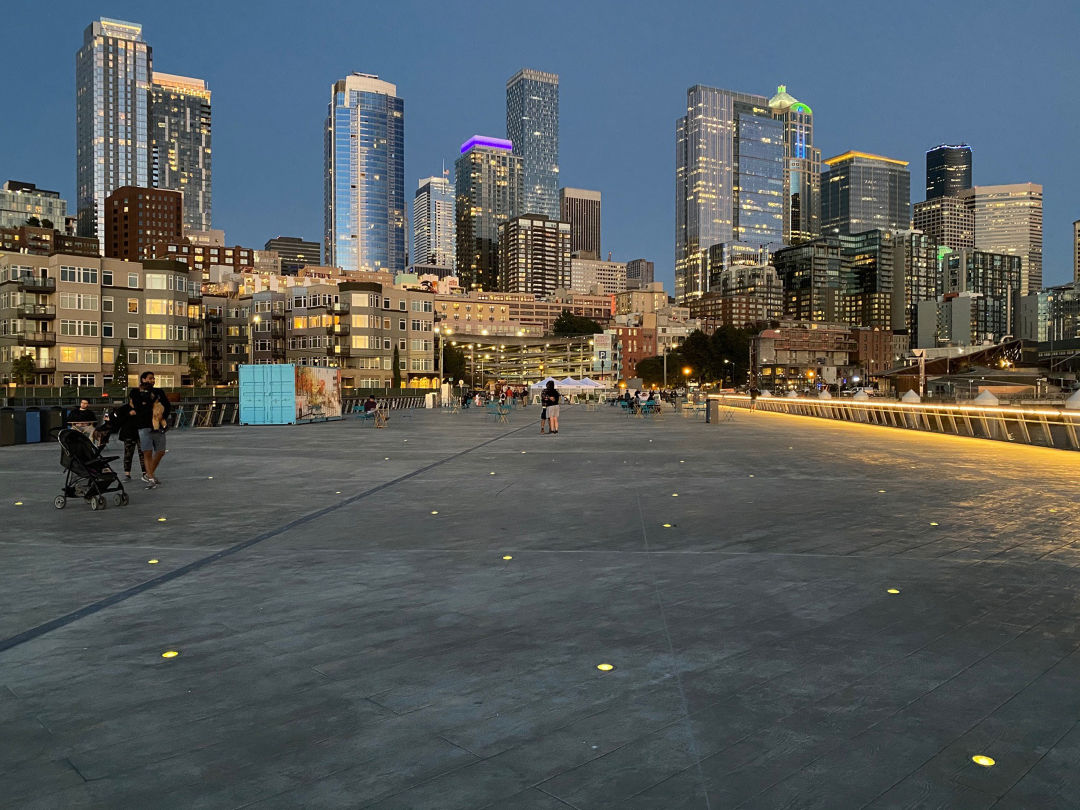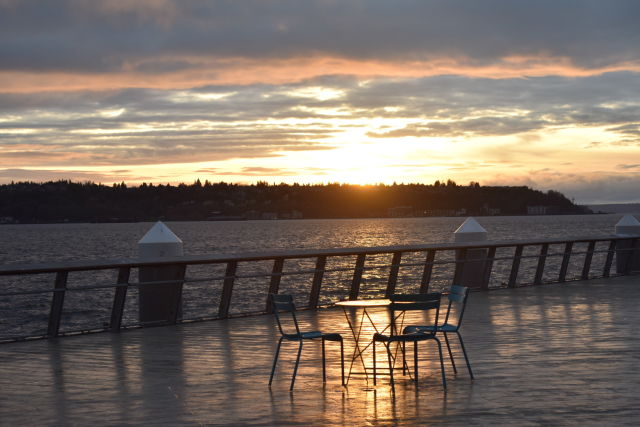Pier 62 Shows Seattle in Its Best Light

All of the lights.
It had been a minute since I’d ventured down to the Waterfront. Over the summer, and deep into pandemic isolation, I’d made a habit of walking the planks above Puget Sound, each waft of marine air a remedy for my cabin fever. But in September, wildfires shrouded the shoreline in smoke. Then, apropos of everything, one of the city’s most popular piers collapsed into Elliott Bay. A stroll to water’s edge suddenly seemed like a hazard to my health. Best to steer clear for a bit, I thought.
Yet, as fall progressed, curiosity won out. Arriving just before sunset one night, I found a tarp draped over a chain-link fence that blocked access to the horseshoe-shaped boardwalk between the Great Wheel and Seattle Aquarium. On the other side of the obstruction, the hole in the pier caused by structural decay and a construction mishap was wide enough to fit a yacht. Plank fragments and other debris filled a large container nearby. It looked like part of Seattle was about to be exported. Another loss.
I was feeling dejected when, while heading north up Alaskan Way, something unfamiliar entered my line of sight. Just past the aquarium, a massive platform extended out into the Sound, a floating dock wiggling at its side. People dawdled on both. Some hooked arms around each other, snapping selfies with the Olympics at their backs. Others sat at fluorescent tables. Everyone seemed…happy. Was this here before?
It wasn’t—at least not since I’d last walked by. One week after concrete came crashing down on its neighboring boardwalk, and nearly three years after its reconstruction began, Pier 62 opened to the public. It hasn’t been a secret per se; nearly 70,000 visitors have roamed the park since its September 20 debut. But those who’ve avoided the Waterfront since Pier 58’s plunge, or those who’ve just stuck close to their homes amid the pandemic, have perhaps missed out on an opportunity to glimpse one element of the Waterfront’s future landscape.
Over the next several years, a partnership between Seattle’s parks department and nonprofit Friends of Waterfront Seattle will help transform a 20-acre strip of the Seattle central shoreline into a walkable, verdant area fit for live music, soccer, and all the Sound’s golden-hour glory. Though the demolition of the Alaskan Way Viaduct helped clear the way for it, Pier 62 is the first major piece of the city’s Waterfront Park project to wrap up, says Marshall Foster, director of Seattle’s Office of the Waterfront and Civic Projects. “It's a platform to create opportunities for art, for the community,” says Foster.
Friends of Waterfront Seattle manages the site’s programming. Its first artist-in-residence, Takiyah Ward, inspired and curated the pier’s inaugural installation by asking local artists, “How do we honor our elders, determine our self, and protect our youth?” Former Garfield High School classmates Chi Moscou-Jackson and Devon Midori Hale, collaborating under the name Psych-Pop, fashioned light sculptures that glowed in the center of the pier for months. Along the pier’s rails, visitors can now access virtual installations via QR codes on information cards. Duwamish artist Jac Oliver Trautman’s “Ken at Alki” casts photographs of Duwamish tribal elder Ken Workman against the pier’s backdrop. “By taking a single exposure with multiple projected images contained within,” Trautman observes on the piece's placard, “I draw attention to the concept of splitting and projection in the ongoing history of interactions between the colonizer and colonized.”
Local tribes can hold ceremonies on the pier, Foster notes. He’s excited about the learning opportunities, both cultural and scientific, the space beckons. The floating dock’s proximity to the aquarium will allow for easy access to marine research vessels. Historic ships can drift in.
Instagram-friendly sunsets aren’t the only entertainment on the horizon either. Foster foresees food trucks and live music in a space that hosted summer concerts until 2005.

Thanksgiving 2020.
Image: Benjamin Cassidy
Safety concerns canceled that series. As with Pier 58, deteriorating piles spelled doom for the original Pier 62. Beginning in 2017, workers began removing the structure’s 884 wooden supports, replacing them with 175 steel legs. They connected a floating dock built in Bellingham to the platform, which is topped with concrete paneling instead of timber.
I’ve long appreciated the creak of a classic boardwalk, but I quickly embraced some sturdier support following Pier 58’s splinter. The yo-yo of activity restrictions related to Covid-19 couldn’t stop me from regularly trekking down to Pier 62 and reveling in the city’s glow. I went after work, during a date, on Thanksgiving.
And, even as more places have reopened, I’ve kept going. Sometimes, I turn east and discern the sunset’s palette in the city’s towers. Most of the time, I’ll head to the westernmost rail and look out at the Sound, watching its waves form the topographies of distant mountains. You’ll find a cross-section of the city’s personalities at this far edge—overachieving runners panting between sprints, techie newcomers and tourists trying to ID mountain ranges, aspiring influencers finding their angles.
There’s another group to behold at this rail. Foster says squid fishermen have frequently visited the pier at dusk, and I’ve seen others toss lines in from this spot too. I marvel at their patience, their stares cast not down at the water but across it, tapped into some angler’s zen that’s always eluded me. I watch them for a while, trying to absorb all of their requisite patience and hope, and then I go home.




